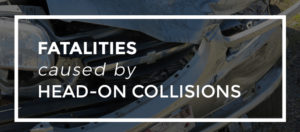 Head-on collisions are widely considered to be one of the most – if not the most – dangerous types of vehicle crashes. Statistics provided by the Department of Transportation estimate that about 18 percent of fatal accidents that took place outside of intersections involved a head-on crash. This number is high considering the overall percentage of accidents that are head-on, indicating that this type of crash tends to have a higher risk of fatalities.
Head-on collisions are widely considered to be one of the most – if not the most – dangerous types of vehicle crashes. Statistics provided by the Department of Transportation estimate that about 18 percent of fatal accidents that took place outside of intersections involved a head-on crash. This number is high considering the overall percentage of accidents that are head-on, indicating that this type of crash tends to have a higher risk of fatalities.
The following are only some reasons why head-on crashes can be so dangerous:
- Speed of Impact – Many head-on collisions happen when both vehicles involved are in motion. Cars may be driving the speed limit – or faster – and may have little to no time to hit the brakes before a sudden impact occurs. The impact has greater force when both vehicles are driving than when one or both are at a stop.
- Size Discrepancy of Vehicles – Another factor that can make a head-on collision deadly is if there is a discrepancy in the size of the vehicles involved. For example, a head-on crash between a car crashing and a motorcycle can be deadly for the motorcyclist. In addition, occupants of a car are at greater risk of injury if their car collides with a large commercial truck.
No matter what factors are involved in a head-on crash, there is still the potential for extremely severe injuries, including spinal cord injury, traumatic brain injury, internal organ damage, internal hemorrhaging, and more. These injuries often cannot be stabilized, and victims of head-on collisions often do not survive.
Who is Liable for the Wrongful Death of an Accident Victim?
Because head-on crashes so often result in the death of a victim, it is important to examine who can be held liable for the losses incurred because of the death. Pennsylvania law allows surviving family members to file a legal claim for wrongful death after a loved one is killed because of the negligence of another party.
In order to recover for wrongful death, it is necessary to identify the liable party and prove the negligent act that caused the fatal crash. The following are some examples of potentially liable parties after a fatal head-on collision:
- Drivers – Many different acts of driver negligence can lead to a head-on collision. For example, distracted driving, impaired driving, and falling asleep at the wheel can all cause a driver to cross over into oncoming traffic and crash. In addition, drunk drivers may drive the wrong way on a highway or one-way street and cause a crash.
- Auto manufacturers – Many defective parts of a vehicle can cause a driver to lose control and veer into oncoming traffic lanes, resulting in a head-on crash. For instance, a tire blowout, brake failure, or steering system failure can all result in loss of control over a vehicle.
- Government entities – Another common reason drivers may swerve or lose control is hazardous road conditions. Whether a driver swerves to avoid a hazard or loses control because he or she hits the hazard, the agency responsible for the maintenance and inspection of that roadway may be liable if a fatal head-on crash occurs.
Contact a Philadelphia Car Accident Attorney for Help as Soon as Possible
Wrongful death actions can be complicated, but at The Levin Firm Personal Injury Lawyers, we are committed to helping families who have suffered a tragic loss in a head-on collision seek the compensation they deserve. We will protect your rights to recover for both financial and emotional losses, and we have the resources to investigate the cause of the accident and hold any negligent parties fully responsible. Please call our Philadelphia car accident lawyer at 215-825-5183 for a free consultation today.